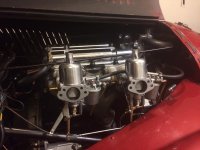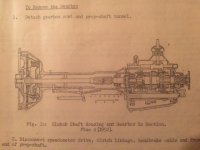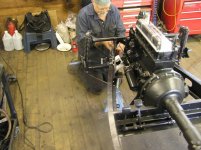Okay Fellas, first post on the site
Over the past week I think I've finally gotten my TR3-powered '60 Morgan back on the road and I'm just working on fine-tuning the carbs. I had the carbs rebuilt by someone else which turned out to be a huge headache and then rebuilt them again myself. They are not leaking at all, and as far as I can tell the vacuum advance is working normally (I can see it move the distributor plate when suction is applied). The car has a TR3 engine with 87mm piston liners and the stock H6 SUs, now running the richer than stock "RH" needles. The engine was completely rebuilt by a reputable TR expert with a new waterpump and aluminum radiator and bellows type block off thermostat. It was also converted to a lead-free head with hardened valve seats.
Over the past month I have also converted to negative earth, switched over to an alternator, welded up a custom manifold-back exhaust with a slightly larger diameter, and installed a wideband oxygen sensor to track AFRs. I also picked up an el-cheapo infrared thermometer to check manifold and radiator surface temps. This seems a little bit more technologically advanced than when the car was built.
When warmed up, the original temp gauge reads about 1/3 way between the normal and hot marks. My handheld thermometer reads about 155F (68.5C) on the aluminum end tank next to the water inlet, and the top radiator hose reads about 165F (73.8C) I attribute this to the shiny aluminum reflecting the laser. The exhaust manifold reads in the 550F (285C) range when warmed up and idling.
At cold idle the AFR is around 12.0, warm Idle it rises to around 13. At throttle while driving and WOT I'm getting around 12.5 with a split second spike into the 15's on overrun from WOT. When using the piston lifting pins, the idle does drop slightly and the engine runs poorly which would normally be indicative of a slightly lean condition, even though my AFRs are on the richer side.
The car otherwise seems to run and idle well. I just didn't know if anyone with more experience with tuning carbs could look at this data and say "looks okay!" or "Oh gosh, it's bound to blow up" before I go out driving more. I'm probably being a bit OCD about this.
Happy Motoring! And thank you in advance for your replies.
Read
Over the past week I think I've finally gotten my TR3-powered '60 Morgan back on the road and I'm just working on fine-tuning the carbs. I had the carbs rebuilt by someone else which turned out to be a huge headache and then rebuilt them again myself. They are not leaking at all, and as far as I can tell the vacuum advance is working normally (I can see it move the distributor plate when suction is applied). The car has a TR3 engine with 87mm piston liners and the stock H6 SUs, now running the richer than stock "RH" needles. The engine was completely rebuilt by a reputable TR expert with a new waterpump and aluminum radiator and bellows type block off thermostat. It was also converted to a lead-free head with hardened valve seats.
Over the past month I have also converted to negative earth, switched over to an alternator, welded up a custom manifold-back exhaust with a slightly larger diameter, and installed a wideband oxygen sensor to track AFRs. I also picked up an el-cheapo infrared thermometer to check manifold and radiator surface temps. This seems a little bit more technologically advanced than when the car was built.
When warmed up, the original temp gauge reads about 1/3 way between the normal and hot marks. My handheld thermometer reads about 155F (68.5C) on the aluminum end tank next to the water inlet, and the top radiator hose reads about 165F (73.8C) I attribute this to the shiny aluminum reflecting the laser. The exhaust manifold reads in the 550F (285C) range when warmed up and idling.
At cold idle the AFR is around 12.0, warm Idle it rises to around 13. At throttle while driving and WOT I'm getting around 12.5 with a split second spike into the 15's on overrun from WOT. When using the piston lifting pins, the idle does drop slightly and the engine runs poorly which would normally be indicative of a slightly lean condition, even though my AFRs are on the richer side.
The car otherwise seems to run and idle well. I just didn't know if anyone with more experience with tuning carbs could look at this data and say "looks okay!" or "Oh gosh, it's bound to blow up" before I go out driving more. I'm probably being a bit OCD about this.
Happy Motoring! And thank you in advance for your replies.
Read

 Hi Guest!
Hi Guest!

 smilie in place of the real @
smilie in place of the real @
 Pretty Please - add it to our Events forum(s) and add to the calendar! >>
Pretty Please - add it to our Events forum(s) and add to the calendar! >> 







